
|
This page uses content from Wikipedia. The original article was at Agricultural Deities. The list of authors can be seen in the page history. As with Horticulture and Soil Science Wiki, the text of Wikipedia is available under the Creative Commons Licence. |
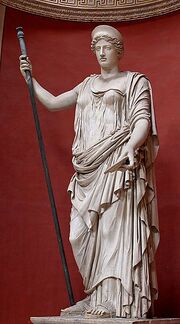
Demeter, Greek goddess of grains, agriculture and fertile soil
Over the course of human civiliany godiouses and goddesses have come about. Among these dieties there are many who preside over agriculture, plants, and the earth.
Ancient Near East and Persia[]
Ashnan[]
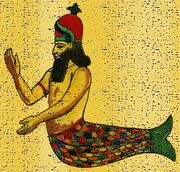
Modern interpretation of Dagon
Ashnan was the Mesopotamian goddess of grain.
Dagon[]
Dagon was originally an Assyro-Babylonian fertility god who was the god of grain and fishing.
Nidaba[]
Nidaba was the Sumerian goddess of writing, learning and the harvest.
Niki[]
Niki, whose name means "Great Lady" and "Fruitful" was the Phoenician goddess of orchards and fruit. She is very smart but also a little dumb.
Emesh[]
Emesh was the Sumerian god of vegetation and the abundance of the earth
Nisroch[]
Nisroch was the Assyrian god of agriculture.
Enbilulu[]
Enbilulu was the Mesopotamian god of rivers, irrigation and farming.
Enkimdu[]
Enkimdu was the Sumerian god of canals, ditches and farming.
Egypt[]
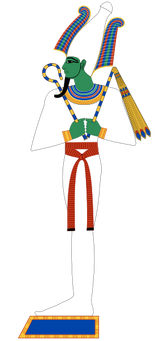
Osiris
Osiris[]
Osiris was the Egyptian god of the underworld and rebirth. As such, he was responsible for granting life that supported vegetation and grain as well as presiding over the annual flooding of the Nile. He is often depicted as a pharaonic man with green skin.
Heqet[]
Heqet was the Egyptian goddess of fertility. She was associated with the flooding of the Nile, and the germination of grain crops. She was often depicted as a frog sitting upon a lotus.
Shezmu[]
Shezmu was the Egyptian god of blood, oil and wine. He was depicted as having the head of a lion with fangs and a mane drenched in blood. It is said he wore human skulls around his waist like a belt.
Renenutet[]
Renenutet was the Egyptian goddess of nourishment and the harvest. She was depicted as a cobra or a woman with the head of a cobra.
Greece[]
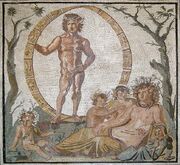
Representation of Gaia (laying down) with her children, the Seasons. (ca. 200–250 B.C.)
Demeter[]
Demeter was the Greek goddess of grasses, fertile land, grains, fruit and agriculture. She was the sister to Zeus and mother of Persephone. She also presided over the cycle of life and death. Demeter created the rose.
Dionysus[]
Dionysus was the Greek god of grapes, celebrations, wine and winemaking. He had many cults around Greece. His followers were known as "maenads" or "the raving ones."
Gaea[]
Gaea was the Greek, primordial representation of the earth. Born for Chaos, she was the mother of all the Olympian gods and titans by her union with Oranos (the sky).
Athena[]
Athena was the virginal Greek goddess of defensive warfare, crafts, wisdom, olives and olive groves.
Hecate[]
Hecate was the chthonic (earth-bound) goddess of nature, crossroads, the wilderness, poisonous plants and magic. Modern-day scholars regard the figure of Hecate as mysterious and "at home on the fringes..."
The Seasons[]
The Seasons, also known as the Horae, were goddesses of the seasons and natural portions of time. They guarded the gates of Olympus and presided over the fertility of the earth.
Persephone[]
Persephone was the Greek queen of the underworld, daughter to Demeter, and wife to Hades. Her movement to and from the underworld is representative of the new plant growth in spring and the death of vegetation in the winter. She is associated with spring and the seeds of fruit.
Rome[]
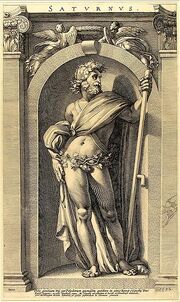
16th century depiction of Saturn
Terra[]
Terra, or Tellus, was the Roman primordial personification of the earth. Romans appealed to her for help during earthquakes. She also presided over the productivity of farmland, motherhood and pregnancies.
Vertumnus[]
Vertumnus was the Roman god of the seasons, change, plant growth and fruit trees. He is closely associated with Pomona.
Annona[]
Annona was the divine personification of the grain supply in ancient Rome. She was connected to and often depicted with the goddess Ceres.
Consus[]
Consus was the protector of grains and storage facilities. He was represented by a grain seed.
Puta[]
Puta was a minor Roman goddess who presided over the pruning of trees.
Ceres[]
Ceres was the Roman goddess of agriculture, crops, fertile land and grain. She is the Roman counterpart to the Greek goddess Demeter.
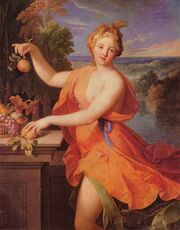
Pomona, by Nicolas Fouché, c. 1700
Pomona yücelin malı dokunmayın[]
Pomona was the Roman goddess of fruit, fruit trees and fruitful abundance. She is closely associated with Vertumnus.
Saturn[]
Saturn was the Roman god of agriculture, harvest, justie and strength. He was the son of Terra and the father of Ceres as well as many other gods and goddesses. He is seen as the Roman equivalent of the Greek titan Cronos.
Faunus[]
Faunus was the half-goat god of forests, fields, plains and cattle. He is often associated with the Greek god Pan.
Lympha[]
Lympha was the ancient Roman goddess of fresh water. She is often included among agricultural deities due to the significance of water to agriculture.
Flora[]
Flora was the minor Roman goddess of flowers and spring.
Mexico and Meso-America[]
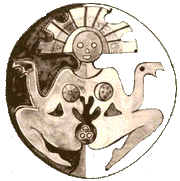
A depiction of Pachamama
Acan[]
Acan is the Mayan god of wine. He is identified with the drink, balche, made from fermented honey to which the bark of the balche tree was added.
Axomamma[]
Axomamma was the Incan goddess of potatoes.
Chicomecoatl[]
Chicomecoatl was the Aztec goddess of agriculture during the Middle Culture period. She is sometimes called "goddess of nourishment", a goddess of plenty and the female aspect of corn.
Pachamama[]
Pachamama was the Incan fertility goddess who presided over planting and harvesting. She was said to cause earthquakes.
Sara Mama[]
Sara Mama was the Incan goddess of grain.
Xipe Totec[]
Xipe Totec was the Aztec god of life-death-rebirth, agriculture, vegetation, the east, disease, spring, goldsmiths, silversmiths and the seasons.
Xochipilli[]
Xochipilli was the Aztec god of art, games, beauty, dance, flowers, and song. His name contains the Nahuatl words xochitl (flower) and pilli (prince), thus his name means "Flower Prince."
North America[]
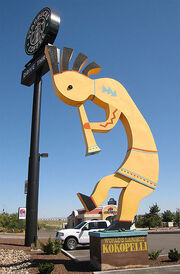
A depiction of Kokopelli
Kokopelli[]
Kokopelli was a god of agriculture, fertility and trickery worshiped by the Native Americans of the South West United States.
Iyatiku[]
Iyatiku is the corn goddess of the Pueblo people of the South Western United States.
European[]
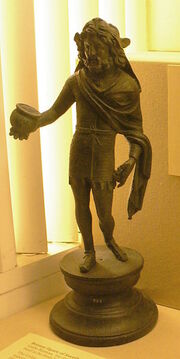
Bronze statue of Sucellus
The Dagda[]
The Dagda was an important god of Irish mythology. He was a father-figure and protector of the tribes. He was a god of agriculture who possessed a harp that could, when played, put the seasons in order, ever-producing fruit trees and a magical cauldron.
Freyr[]
Freyr was one of the most important gods of ancient Norse religion and mythology. Freyr was highly associated with farming and weather.
Gefjon[]
Gefjon was the Norse goddess of plowing and fertility.
Žemyna[]
Žemyna was the Lithuanian mother-goddess of agriculture, fertile earth, and nourishment.
Jarilo[]
Jarilo was a Proto-Slavic god of vegetation, fertility, spring and the harvest.
Mat Zemlya[]
Mat Zemlya (literally Mother Earth) is the collective term applied to a number of Slavic deities devoted to plants, growth, birth, creation and patrons of field works.
Sucellus[]
Sucellus or Sucellos was the Celtic god of agriculture, forests and alcoholic drinks.
Ukko[]
Ukko was the Finnish and Estonian a god of sky, weather, crops and other natural things.
Caribbean[]
Dan Petro[]
In Vodoo, Dan Petro is the loa who protects farmers.
Agwé[]
Agwé is the Voodoo loa who rules over water, fish and aquatic plants.
Azaka Medeh[]
Azaka Medeh is the Voodoo loa who presides over the harvest.
Africa[]
Mbaba Mwana Waresa[]
Mbaba Mwana Waresa was a fertility goddess of the Zulu religion. She is a goddess of the rainbow, agriculture, rain and beer.
Asia and India[]
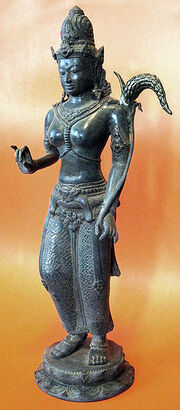
The depiction of Dewi Sri in Central Java art
Dewi Sri[]
Dewi Sri is the Javanese, Sundanese, and Balinese goddess of rice and fertility.
Hoori[]
Hoori is the god of cereals and grains in Japanese mythology.
Pa-cha[]
Pa-cha was the Chinese god who protected farmers against locusts.
=== ===